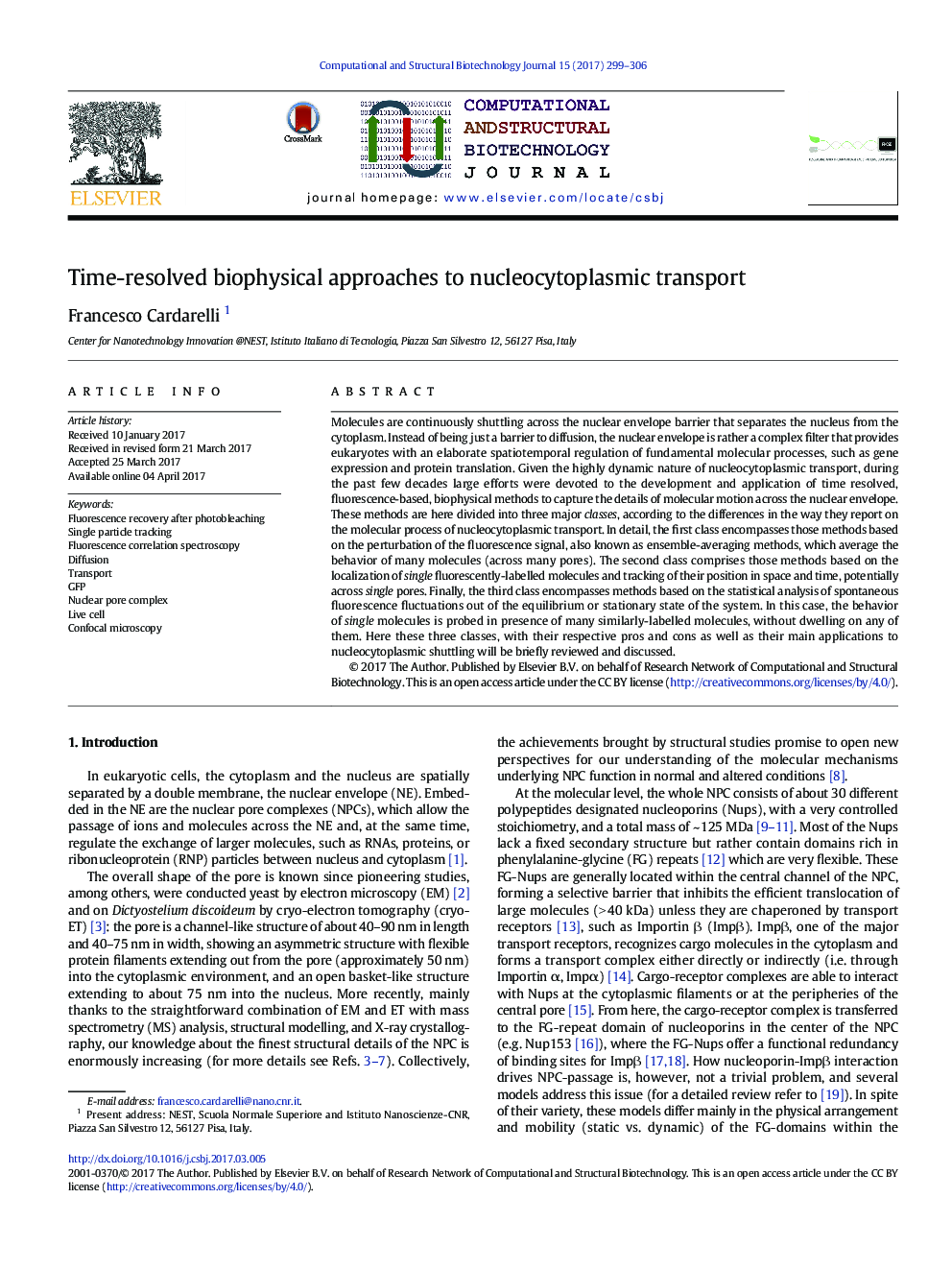| کد مقاله | کد نشریه | سال انتشار | مقاله انگلیسی | نسخه تمام متن |
|---|---|---|---|---|
| 8408531 | 1545070 | 2017 | 8 صفحه PDF | دانلود رایگان |
عنوان انگلیسی مقاله ISI
Time-resolved biophysical approaches to nucleocytoplasmic transport
ترجمه فارسی عنوان
رویکردهای بیوفیزیکی زمانبره شده برای حمل و نقل نوکلئوسیت پالسمیک
دانلود مقاله + سفارش ترجمه
دانلود مقاله ISI انگلیسی
رایگان برای ایرانیان
کلمات کلیدی
GFPTransport - حمل و نقل یا ترابریSingle particle tracking - ردیابی ذرات تکLive cell - سلول زندهfluorescence correlation spectroscopy - طیف سنجی همبستگی فلورسانسfluorescence recovery after photobleaching - فلوئورسانس پس از فوتوبلاسیکnuclear pore complex - مجتمع مخرب هسته ایConfocal microscopy - میکروسکوپ کانفوکالDiffusion - واپخش یا انتشار
ترجمه چکیده
مولکول ها به طور مداوم در معرض مانع هسته ای قرار می گیرند که هسته را از سیتوپلاسم جدا می کند. به جای اینکه تنها مانع انتشار شود، پاکت هسته ای نه یک فیلتر پیچیده ای است که اریکیوت ها را با یک تنظیم دقیق فضایی موقت از فرآیندهای مولکولی اساسی مانند بیان ژن و ترجمه پروتئین فراهم می کند. با توجه به ماهیت بسیار پویایی حمل و نقل نوکلئوسیت پالسمیک، طی دهه های گذشته تلاش های زیادی برای توسعه و استفاده از روش های زمانبندی شده، فلورسانس، بیوفیزیکی برای ترسیم جزئیات حرکت حرکت مولکولی در داخل پاکت هسته اختصاص داده شده بود. این روش ها در اینجا به سه طبقه اصلی تقسیم می شوند، با توجه به تفاوت ها در نحوه گزارش پروسه مولکولی حمل و نقل نوکلئوسیت پالسمیک. به طور دقیق، کلاس اول شامل این روش ها بر اساس اختلال سیگنال فلورسانس است که همچنین به عنوان روش های میانگین سازگاری شناخته می شود، که میانگین رفتار مولکول های بسیاری را در میان بسیاری از منافذ می داند. طبقه دوم شامل این روش ها بر اساس مکان یابی مولکول های تکثیر شده فلورسنتال و ردیابی موقعیت آنها در فضا و زمان، به طور بالقوه در داخل منافذ منافذ است. در نهایت، کلاس سوم شامل روش هایی است که بر اساس تجزیه و تحلیل آماری نوسانات فلورسنت خودبه خودی از حالت تعادل یا حالت ثابت سیستم است. در این حالت، رفتار مولکول های تک در حضور بسیاری از مولکول های برچسب گذاری شده مشابه، بدون محل سکونت در هر یک از آنها مورد بررسی قرار می گیرد. در اینجا این سه طبقه با مفاهیم و منافع خاص خود و همچنین برنامه های اصلی آنها برای انتقال به هسته کولیتوپلاسمیک به طور خلاصه مورد بررسی و بحث قرار می گیرند.
موضوعات مرتبط
علوم زیستی و بیوفناوری
بیوشیمی، ژنتیک و زیست شناسی مولکولی
بیوتکنولوژی یا زیستفناوری
چکیده انگلیسی
Molecules are continuously shuttling across the nuclear envelope barrier that separates the nucleus from the cytoplasm. Instead of being just a barrier to diffusion, the nuclear envelope is rather a complex filter that provides eukaryotes with an elaborate spatiotemporal regulation of fundamental molecular processes, such as gene expression and protein translation. Given the highly dynamic nature of nucleocytoplasmic transport, during the past few decades large efforts were devoted to the development and application of time resolved, fluorescence-based, biophysical methods to capture the details of molecular motion across the nuclear envelope. These methods are here divided into three major classes, according to the differences in the way they report on the molecular process of nucleocytoplasmic transport. In detail, the first class encompasses those methods based on the perturbation of the fluorescence signal, also known as ensemble-averaging methods, which average the behavior of many molecules (across many pores). The second class comprises those methods based on the localization of single fluorescently-labelled molecules and tracking of their position in space and time, potentially across single pores. Finally, the third class encompasses methods based on the statistical analysis of spontaneous fluorescence fluctuations out of the equilibrium or stationary state of the system. In this case, the behavior of single molecules is probed in presence of many similarly-labelled molecules, without dwelling on any of them. Here these three classes, with their respective pros and cons as well as their main applications to nucleocytoplasmic shuttling will be briefly reviewed and discussed.
ناشر
Database: Elsevier - ScienceDirect (ساینس دایرکت)
Journal: Computational and Structural Biotechnology Journal - Volume 15, 2017, Pages 299-306
Journal: Computational and Structural Biotechnology Journal - Volume 15, 2017, Pages 299-306
نویسندگان
Francesco Cardarelli,
